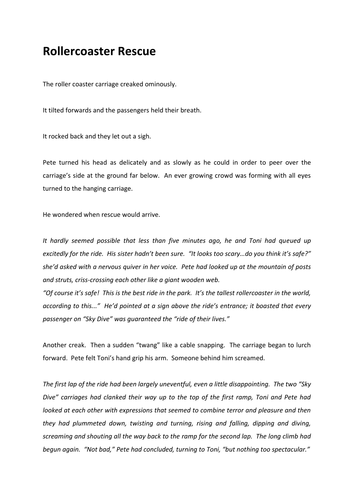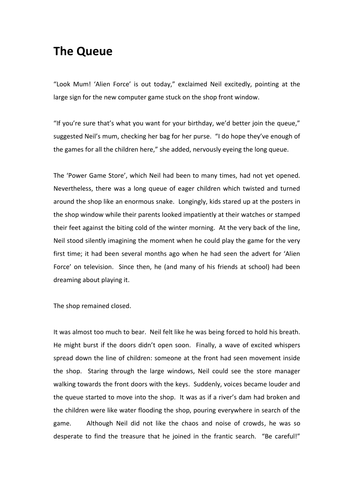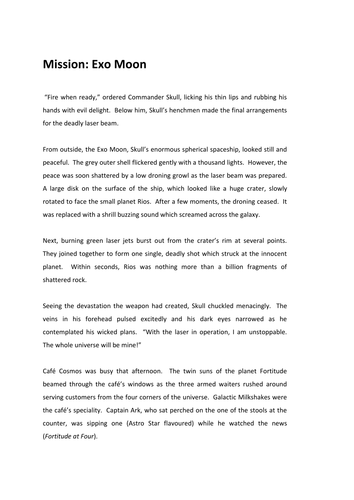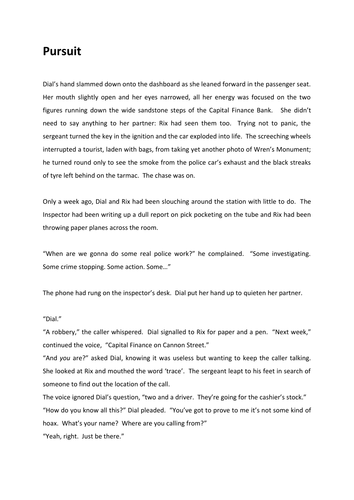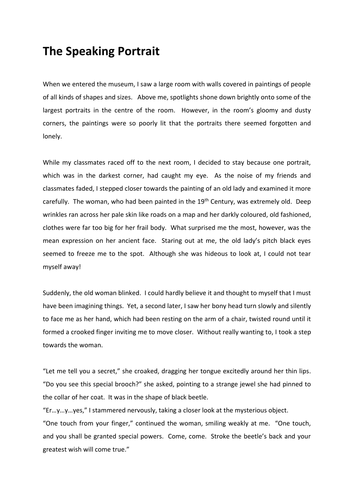
27Uploads
30k+Views
6k+Downloads
All resources

Narrative Writing: Crooked
When Ludwig and Marta find a map in their new house’s cellar, they begin an adventure which takes them to a ruined castle and a terrifying crooked man!
A long-ish quest / suspense narrative (8 pages) which could be used for guided or shared reading or as a modelled text to teach a variety of objectives (see Teaching Points below). There is a set of KS2 SAT style comprehension questions based on the text.
Teaching Points:
GRAMMAR: past tenses (including past perfect); fronted adverbials; adjectives and adverbs for descriptive detail; connectives (contrast and time); relative clauses; 3rd person narration
PUNCTUATION: commas around clauses; exclamation and question marks; speech marks; ellipsis; colons and semi-colons
STRUCTURE: paragraphing, including short paragraphs and sentences for dramatic effect; balance of action, dialogue and setting; repetition of phrases for effect
CONTENT & THEME: quest, suspense narrative; character (villain, brother-sister); resolution with surprise; rhetorical questions; figurative language (simile, metaphor, alliteration)

Narrative Writing: Rollercoaster Rescue
Pete and his sister are stranded on the top of a rollercoaster ride; their carriage hangs precariously at the top of the slope. Will they be rescued in time?
A short narrative (4 pages) which could be used for guided or shared reading or as a modelled text. The story uses flashbacks which might work as a good model for ‘greater depth’ writing. See Teaching Points below.
There is also an annotated text which highlights the following:
Teaching Points:
GRAMMAR: past tenses (including past perfect); fronted adverbials; adjectives and adverbs for descriptive detail; connectives (contrast and time); relative clauses; 3rd person narration
PUNCTUATION: commas around clauses; exclamation and question marks; speech marks; ellipsis; dashes; semi-colons
STRUCTURE: paragraphing, including short paragraphs and sentences for dramatic effect; use of flashback; balance of action, dialogue and setting
CONTENT & THEME: disaster/rescue/bravery; character (brother-sister); resolution links with opening; rhetorical questions; figurative language (similes)

Narrative Writing: The Queue
Neil joins the queue for a shop selling the latest computer game…
A short (2 page) narrative which could be used for guided or shared reading or as a modelled text to teach a variety of objectives (see Teaching Points below).
Teaching Points:
GRAMMAR: past tenses; fronted adverbials; adjectives and adverbs for descriptive detail; connectives (contrast and time); relative clauses; 3rd person narration
PUNCTUATION: commas around clauses; exclamation and question marks; speech marks; brackets
STRUCTURE: paragraphing, including short paragraphs and sentences for dramatic effect; balance of action, dialogue and setting
CONTENT & THEME: build of excitement; character; resolution with surprise; question to the reader; figurative language (simile, metaphor)

Narrative Writing: Exo Moon
Can Captain Ark and his crew stop Commander Skull from destroying the galaxy?
The beginning of a science fiction (think Star Wars) narrative (2.5 pages) which could be used for guided or shared reading, as a modelled text or as an opening prompt for students to continue.
Teaching Points:
GRAMMAR: past tenses; fronted adverbials; adjectives and adverbs for descriptive detail; connectives (contrast and time); relative clauses; 3rd person narration
PUNCTUATION: commas around clauses; exclamation and question marks; speech marks; brackets
STRUCTURE: paragraphing, balance of action, dialogue and setting
CONTENT & THEME: science-fiction; character (hero, villain); figurative language (simile)

Narrative Writing: Pursuit
Two police officers chase bank robbers across London…
A short narrative (4+ pages) which could be used for guided or shared reading or as a modelled text to teach a variety of objectives (see Teaching Points below). It comes with a plan of the story using OBDER (opening, build-up, dilemma, events, resolution). The story uses flashbacks which might be useful for modelling ‘greater depth’ writing.
Teaching Points:
GRAMMAR: past tenses (including past perfect); fronted adverbials; adjectives and adverbs for descriptive detail; connectives (contrast and time); relative clauses; 3rd person narration; complex sentences
PUNCTUATION: commas around clauses; exclamation and question marks; speech marks; semi colons
STRUCTURE: paragraphing; short paragraphs and sentences for dramatic effect; balance of action, dialogue and setting; use of flashback; resolution links back to opening
CONTENT & THEME: action, chase; character (police heroes, villains); figurative language (similes); geographical detail

Narrative Writing: The Speaking Portrait
During a dull school trip to an art gallery, the narrator sees one of the portraits being to move…
A short narrative (2 pages) which could be used for guided or shared reading or as a modelled text.
Teaching Points:
GRAMMAR: past tenses; fronted adverbials; adjectives and adverbs for descriptive detail; connectives (contrast and time); relative clauses; first person narration; rhetorical questions
PUNCTUATION: commas around clauses; exclamation and question marks; speech marks; ellipsis
STRUCTURE: paragraphing (opening, build-up, events, resolution); balance of action, dialogue and setting
CONTENT & THEME: stepping into another world; setting based opening; character (old lady in portrait); cliff-hanger ending; figurative language (similes)

Snow Day: Snowbound Texts
After a heavy snowstorm, staff and students at a school have been forced to spend the night, entirely cut off from the outside world…
Here are 5 texts which describe the experience:
It’s Snowing!: a story describing the the reaction of students as the snow begins to fall at school.
Night: a poem describing the atmosphere as students try to sleep in a classroom.
A Search Party: a discussion text outlining arguments for and against sending out a search party to look for help.
Expedition: an action story in which a search party attempt to brave the outside.
Safe at Last!: a news report detailing the rescue of the staff and students.
All brilliantly illustrated by Nick Hilditch
These texts could be used in a variety of ways:
exploring and comparing different text types or genres;
texts for whole class or guided reading;
the basis of reading comprehensions;
modelled texts for students’ own writing.
Language features:
Narrative Writing: past tenses, including past perfect; fronted adverbials; adjectives and adverbs for descriptive detail; coherence; relative clauses; commas around clauses; semi-colons; colons; ellipsis; inverted commas; paragraphing, including short paragraphs and sentences for dramatic effect; balance of action, dialogue and setting; themes of adventure, rescue, overcoming fear; character description; figurative language (simile, metaphor).
Poetry: metaphor; figurative language; personification; contrasts; patterns; alliteration; repetition.
Discussion: formal writing; direct address; objectivity; quotations; sentence adverbs; punctuation range.
News Report: layout; report structure; direct and reported speech; formal language.


